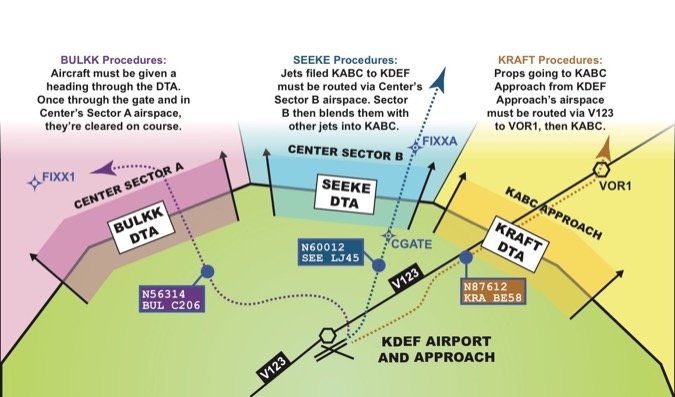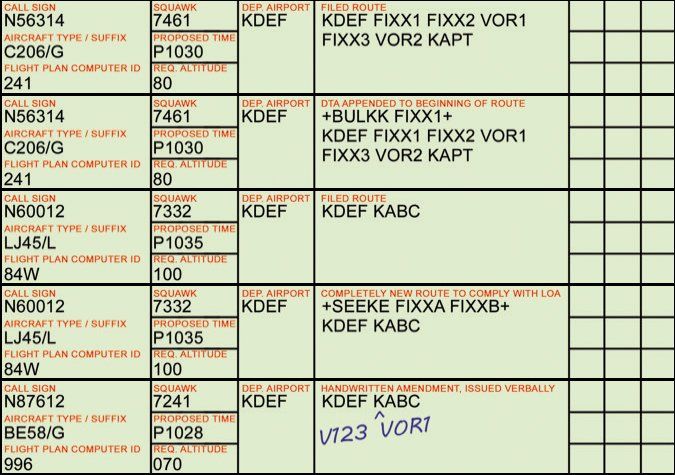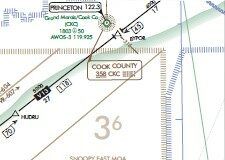Some things are inevitable. Sunrises and sunsets. A character in every Star Wars movie saying, “I’ve got a bad feeling about this.” Also… at some point during your instrument flying career, you’re going to get your first of many reroutes.
Inconvenient as they can be, reroutes aren’t “vectors for controller amusement.” As both an air traffic controller and a pilot, I wish I could give everyone direct. However, in my day-to-day life working traffic, I know that’s not going to happen for everyone. No one likes burning extra time and gas without a good reason, so let’s take a look at the what and the why that goes into these changes.
On Ramps and Off Ramps

Imagine you live in the Washington D.C. area and want to take a road trip up to New York City. The fastest route between two points is a straight line, of course. What’s the quickest travel route from D.C. to NYC? Interstate 95, which runs the US east coast all the way from Florida to Maine.
Unfortunately, reality dictates that convenience is often mitigated by order, safety, and practicality. You can’t legally just drive from your home directly at the interstate, smash through the guard rail, and shove yourself into (very surprised) traffic. You must first navigate your local streets and traffic lights, then use an on-ramp to merge onto I-95 in an orderly fashion. After staying on I-95 for another 200+ miles, you reverse the process: a clean exit via an off-ramp, then local streets to your final destination in the Big Apple.
Air traffic control routing (and rerouting) operates in much the same way: get aircraft up and down in a structured manner. Terminal radar approach controls (TRACONs) that oversee the airspace around major airports have letters of agreements (LOAs) with the air route traffic control centers (ARTCCs) that overlie and surround their airspace. These LOAs dictate how, where, and at what altitude aircraft should be fed between the facilities.
The areas at which aircraft enter and depart a radar facility’s airspace are called Arrival Transition Areas (ATAs) and Departure Transition Areas (DTAs). Colloquially, we controllers call them “gates.” Each gate’s name is usually determined by a prominent fix or navaid in its vicinity. For instance, a gate near an intersection named BULKK could be established in an LOA as the “BULKK gate.”
These gates are ATC’s equivalent of interstate on- and off-ramps. They have defined dimensions both geographically and in altitude. Some might only permit arrivals; others just departures. Some permit both, as long as coming-and-going traffic is separated vertically. Some have speed restrictions. For some, the aircraft must be level at an assigned altitude before hitting the gate. Others, the aircraft can still be on their way up or down to that assigned altitude. Some need to be on a heading through a gate; others can be cleared to their next fix as long as it takes them through the gate.
As important as these gates are, you won’t see any of them depicted on any VFR or IFR pilot chart. You won’t know where they are, how high they go, and how the next ATC facility expects to be receiving you. Meeting those expectations isn’t on you; it’s on the controller.
When we controllers are in training, a huge portion of our studies revolve around those ATA/DTA procedures. All of those details need to be on instant recall. I can’t just hit pause with fifteen aircraft on my frequency and research whether or not N132AB needs a heading or can be just cleared to a fix. I need toknowit.
Getting on the Rails
Due largely to those ingress and egress gates, the route you file may not always be the route you get. Think about this: what if going direct to a destination would run you opposite direction to an exit-only gate? Would you drive head-on into oncoming traffic on the ground? The same common sense applies in the air. You’ll need to be re-cleared via an appropriate ATA so you don’t play chicken with other planes.
Now, how complex can those reroutes get? Some ATA/DTA procedures are simple—more minor detours than full-on reroutes. For instance, one might just require airplanes be given a heading towards the gate. After you take off, Departure will put you on an appropriate heading and hand you off. Once you’re in the receiving controller’s airspace, they can clear you on course to your first filed fix. Easy. You wouldn’t have to amend a thing in your GPS or FMS, just go “Direct to…” when cleared to do so.
Others, well, let’s just say there are many things to consider, like aircraft type and performance. Imagine two TRACONs bordering each other: KABC Approach and KDEF Approach. They share a gate called KRAFT. KABC is a big class Bravo airport with streams of jets being fed to them by their overlying center, and would rather not get blindsided by high-performance, low-altitude jets from KDEF, so the KABC-KDEF LOA explicitly prohibits jets through the KRAFT gate.
What happens if KDEF Approach gets the inevitable jet filed direct to KABC? KDEF must re-route the jet via fixes or navaids that would take them out a different gate, directly into the center’s airspace, allowing the center controllers to smoothly merge the aircraft into the lines of other jets going into KABC. It adds a few flying miles to the jet, but at the benefit of safety and order.
What if the KDEF-KABC aircraft is a piston or turboprop aircraft instead? KABC still doesn’t want them flying willy-nilly through their airspace. The LOA could require any KABC-bound propeller traffic to be cleared to KABC via a specific airway, connecting to a VOR in KABC’s airspace, andthendirect to KABC. Now all props are on the airway, and KABC can peel them off towards the airport when they’re ready.
One last caveat, which comes from a saying in ATC: “Anything’s possible with coordination.” Depending on weather or other priority, KDEF could verbally coordinate on a case-by-case basis. For instance, if a KDEF-to-KABC jet is a Medevac—an air ambulance—or if weather is impacting the center’s gate, KDEF could just ask for direct KABC. The answer might still be “no,” but there’s no harm in asking.

Pointing the Way
The actual re-routing happens via a number of methods. Sometimes your flight plan is amended automatically by the ATC computers, especially if it’s a common amendment. For instance, regarding the KDEF-to-KABC jet mentioned earlier, both TRACONs and their overlying center could negotiate a standardized route that is automatically “plugged in” to each flight plan that meets certain criteria. Is it a jet, filed from KDEF to KABC? Bam. The computer punches in that new routing without human intervention. Then KDEF’s controllers issue it on-frequency.
Depending on the facility’s procedures, the controllers may amend flight plans by hand. An approach facility where I used to work had numerous military restricted areas and MOAs in the vicinity. Since they went “hot” at random times, we couldn’t really have standardized routes around them. We would have to get on the Flight Data Input Output (FDIO) keyboard and manually amend each affected flight’s route to fixes that would take them around the active areas.
Some facilities require the local controllers to get reroutes from the overlying center. Behind the radar controllers, each center has other departments—like weather and traffic flow management—supporting them and the towers and TRACONs under their purview. Naturally, they have a section dedicated to managing and amending aircraft routings. The center routing folks are supposed to make sure any flight plan amendments are in a half hour before the flight’s proposed departure time. If they’re late, they call the affected tower or TRACON to make sure they have time to change it before the flight takes off.
Controllers are expected to inspect each flight plan for bad routings and change them when needed. If a departure doesn’t have a DTA gate, for example, I’d call the center routing people via a direct landline and request they amend it. This ensures the flight will exit via a gate appropriate for the rest of its flight plan, and will be handed off to the correct sector.
The amendment also adds three character visual cues to the flight’s radar target. Are you a departure going out the BULKK gate? Your radar target will display—along with your call sign, aircraft type, requested altitude, airspeed, and current altitude—the word “BUL”. Going out the KRAFT gate? It would show “KRA”. At a glance, many of my questions are answered: who and where you are, how high you want to climb, what general kind of plane you’re flying, and at which gate Departure needs to point you.
Finally, sometimes, there’s no computer amendment at all. Take the previous example of propeller aircraft cleared from KDEF to KABC via an airway, a VOR, and then direct to KABC. The controllers at KABC are already expecting relevant aircraft to be on that routing. The KDEF controllers know that per the LOA, they must clear each airplane that way, or else they’d be violating procedures. Therefore, amending the routing in the computer is redundant. The only thing necessary is a verbal clearance from KDEF’s controllers.
Confusingly Simple
Just getting off the ground can involve a reroute of sorts. While some control towers just assign aircraft basic headings and altitudes for departures, others use Standard Instrument Departures.
At first glance, many of these SIDs can be an intimidating tangle of fixes, restrictions, and altitudes. However, the most complex are reserved for high performance jets and turboprops with advanced navigation capabilities. If Clearance Delivery issues you a SID, and you hadn’t already filed one, don’t panic. If you’re flying a Piper Cherokee, you’re not going to be assigned a complete high altitude SID that tops out in the flight levels. It could be a lot easier than expected.
The SID could be as easy as “Climb on runway heading or as assigned. Expect radar vectors to join filed route. All aircraft maintain 3000 feet. Departure frequency 134.2.” The primary thing to understand is that SIDs are designed to cut back on phraseology, frequency congestion, and confusion. They keep things simple.
Rather than the controller having to tell you all that, they simply say, “Cleared to [destination] via [SID name], then as filed.” All the instructions—the runway heading, the radar vectors, the altitude to maintain, the departure frequency—are all in black and white in front of you.
If you have any questions, just ask a controller. We get them all the time, from all levels of pilots (airline drivers included). What heading should you fly? What frequency should you use? What altitude should you maintain? It’s probably not the first time that question’s been asked. Honestly, it gets our noses in the books too, reviewing our SID procedures. Never a bad thing.
Just Passing Through
I keep talking about ATAs and DTAs—emphasis on the Arrival and Departure parts of the acronyms. Those words imply landing or taking off inside a particular facility’s airspace.
What if you’re not doing either of those things and are already just cruising through it along your filed route? Even then, reroutes may be in order. An example I already mentioned are MOAs and restricted areas going active after you took off.
Alternately, reroutes could be made simply to facilitate computer automation. Rather than force the computer or controller to guess which sector the airplane will enter next, we route them in a specific way so that they’ll always go to the correct sector. Or, if a flight is filed directly through some seriously complex airspace—think of the madness around New York City—the controllers aren’t just going to let them cruise through swarms of climbing and descending airliners. They’ll put the plane on a safe path around it.
As with all reroutes, these often get amended in the computer—or possibly not. And, as before, controllers will accomplish that reroute however it’s spelled out in LOAs between the affected facilities. There are hundreds of ATC facilities in the United States, and each has LOAs with its neighbors. The variety and complexity of airspace design means that there’s no “one size fits all” when it comes to those procedures. The types of reroutes you’ll get will change continually as you fly across the country.
Air traffic control’s job is to carve order out of chaos. These gates, reroutes, and related procedures are all means towards that end. Are they always convenient? Of course not. Look at the big picture, though. If you’re getting a reroute, that’s the ATC system at work, making things safer and more organized for you and others sharing the sky.




